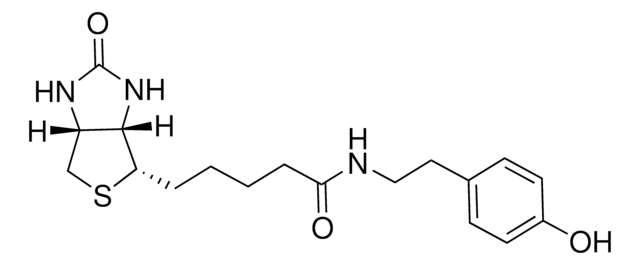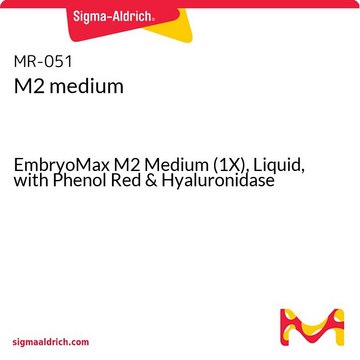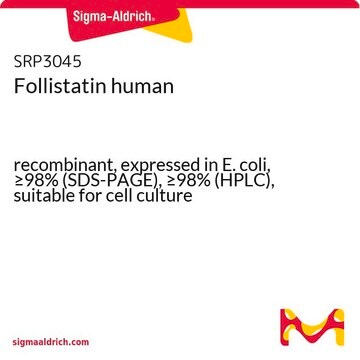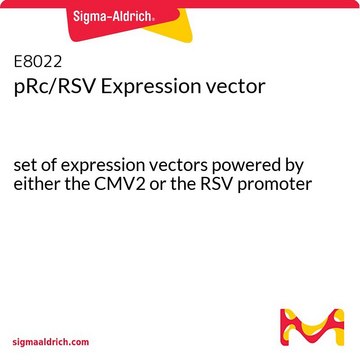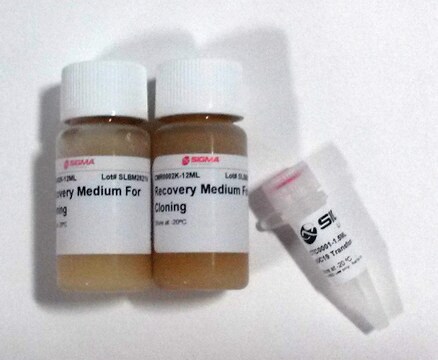F1175
Follistatin 300 human
≥90% (SDS-PAGE), recombinant, expressed in Sf21 cells, lyophilized powder, suitable for cell culture
Synonym(e):
FS 300
Anmeldenzur Ansicht organisationsspezifischer und vertraglich vereinbarter Preise
Alle Fotos(1)
About This Item
Empfohlene Produkte
Biologische Quelle
human
Qualitätsniveau
Rekombinant
expressed in Sf21 cells
Assay
≥90% (SDS-PAGE)
Form
lyophilized powder
Wirksamkeit
0.1-0.4 mg per mL
Mol-Gew.
31 kDa
Verpackung
pkg of 25 μg
Lagerbedingungen
avoid repeated freeze/thaw cycles
Methode(n)
cell culture | mammalian: suitable
Verunreinigungen
endotoxin, tested
UniProt-Hinterlegungsnummer
Lagertemp.
−20°C
Angaben zum Gen
human ... FST(10468)
Allgemeine Beschreibung
FST (follistatin) is an activin-binding protein, and exists in two isoforms due to alternate splicing, FS288 and FS315. It is a glycoprotein with a single chain, and acts as an activin antagonist. It has a high level of expression in fetal membranes and placenta.
Anwendung
FST (follistatin) has been used for trophoblast fusion assay and the measure of hCG (human chorionic gonadotropin) concentration in hormone assays. It is also suitable for the development of chondrocytes from hESc (human embryonic stem cells) by a new 3-Stage directed differentiation protocol (DDP).
Biochem./physiol. Wirkung
FST (follistatin) binds to and regulates activins, which in turn are TGF (transforming growth factor)-β superfamily members. The expression level of FST and its binding partner activin A is elevated in inflammatory disorders. The activin A-follistatin system plays an essential role in the modulation of glucose and lipid metabolism, which might have an overall effect on fetal growth. In adipose tissue, it facilitates the adipogenic differentiation of progenitor cells.
High-affinity activin-binding protein that can act as an activin antagonist.
Physikalische Form
Lyophilized from a solution in 30% acetonitrile and 0.1% trifluoroacetic acid containing 1.25 mg bovine serum albumin.
Hinweis zur Analyse
The biological activity is measured by its ability to neutralize activin-induced bioactivity on K562 cells (erythroid differentiation).
Signalwort
Danger
H-Sätze
P-Sätze
Gefahreneinstufungen
Eye Dam. 1 - Skin Irrit. 2
Lagerklassenschlüssel
11 - Combustible Solids
WGK
WGK 3
Flammpunkt (°F)
Not applicable
Flammpunkt (°C)
Not applicable
Hier finden Sie alle aktuellen Versionen:
Besitzen Sie dieses Produkt bereits?
In der Dokumentenbibliothek finden Sie die Dokumentation zu den Produkten, die Sie kürzlich erworben haben.
S Iemura et al.
Proceedings of the National Academy of Sciences of the United States of America, 95(16), 9337-9342 (1998-08-05)
In early development of Xenopus laevis, it is known that activities of polypeptide growth factors are negatively regulated by their binding proteins. In this study, follistatin, originally known as an activin-binding protein, was shown to inhibit all aspects of bone
O Hashimoto et al.
The Journal of biological chemistry, 272(21), 13835-13842 (1997-05-23)
There are two types of the activin-binding protein follistatin (FS), FS-288 and FS-315. These result from alternative splicing of mRNA. FS-288 exhibits high affinity for cell-surface heparan sulfate proteoglycans, whereas FS-315 shows low affinity. To understand the physiological role of
Rachel A Oldershaw et al.
StemBook, 2012 Jun 10 (2013-05-10)
We have developed for hESc a new 3-Stage directed differentiation protocol (DDP) to generate chondrocytes, the specialized cells that form cartilage tissue. The protocol is segmented into stages that mimic the developmental processes that occur in cell lineage specification during
Rita Linko et al.
BMC infectious diseases, 14, 253-253 (2014-06-03)
Activin A and its binding protein follistatin (FS) are increased in inflammatory disorders and sepsis. Overexpression of activin A in the lung causes similar histopathological changes as acute respiratory distress syndrome (ARDS). ARDS and severe respiratory failure are complications of
Silvia Näf et al.
PloS one, 9(4), e92175-e92175 (2014-04-26)
The Activin A-Follistatin system has emerged as an important regulator of lipid and glucose metabolism with possible repercussions on fetal growth. To analyze circulating activin A, follistatin and follistatin-like-3 (FSTL3) levels and their relationship with glucose metabolism in pregnant women
Unser Team von Wissenschaftlern verfügt über Erfahrung in allen Forschungsbereichen einschließlich Life Science, Materialwissenschaften, chemischer Synthese, Chromatographie, Analytik und vielen mehr..
Setzen Sie sich mit dem technischen Dienst in Verbindung.
